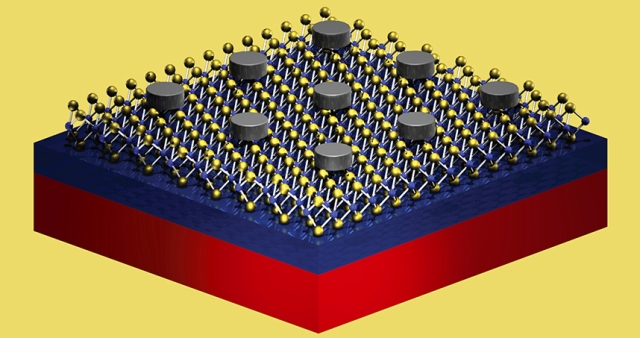Mar 31 2015
 Silver nanodiscs on monolayer molybdenum disulfide
Silver nanodiscs on monolayer molybdenum disulfide
A team from the McCormick School of Engineering have fabricated a silver nanodisc series arranged in a periodic manner over molybdenum disulfide (MoS2).
The nanodisc was designed based on the combination of plasmonics, materials science and nanotechnology. The findings showed that the 130nm diameter nanodiscs have enhanced light emission characteristics.
MoS2 is the most promising material with an inherent characteristic, monolayer thickness, which is its greatest advantage and also a challenge.
The ultra-thin structure of MoS2 makes it flexible, lightweight and strong for a range of applications including high-performance, flexible electronics.
However, this thin semiconducting material does not interact much with light, posing a challenge in light emitting and absorbing applications.
“The problem with these materials is that they are just one monolayer thick. So the amount of material that is available for light emission or light absorption is very limited. In order to use these materials for practical photonic and optoelectric applications, we needed to increase their interactions with light,” said Koray Aydin, assistant professor of electrical engineering and computer science at the McCormick School of Engineering.
“We have known that these plasmonic nanostructures have the ability to attract and trap light in a small volume. Now we’ve shown that placing silver nanodiscs over the material results in twelve times more light emission,” said Serkan Butun, a postdoctoral researcher in Aydin’s lab.
Using nanostuctures instead of a continuous film over the MoS2 enables the material to retain its natural mechanical properties and flexibility. In addition, the enhanced light emission properties make the MoS2 a suitable option for light emitting diode technologies.
The team is further working on improving the light absorption abilities of the material using the same principle, to provide an ideal solution for photodetectors and solar cells.
The research published in the NanoLetters journal was supported by the Northwestern’s Materials Research Science and Engineering Center and the Institute for Sustainability and Energy at Northwestern.
The large-area monolayer MoS2 material used in the research was provided by the assistant professor of materials science and engineering at Arizona State University, Sefaatiin Tongay.
“This is a huge step, but it’s not the end of the story. There might be ways to enhance light emission even further. But, so far, we have successfully shown that it’s indeed possible to increase light emission from a very thin material,” Aydin said.